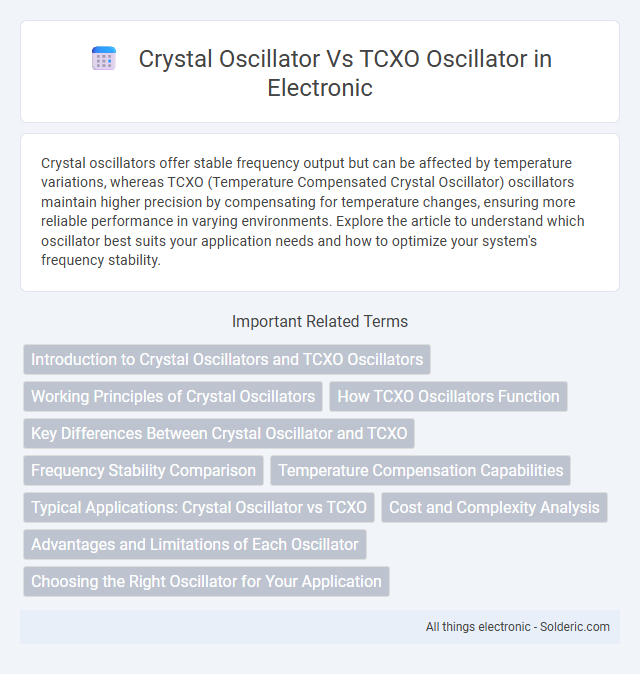Crystal oscillators offer stable frequency output but can be affected by temperature variations, whereas TCXO (Temperature Compensated Crystal Oscillator) oscillators maintain higher precision by compensating for temperature changes, ensuring more reliable performance in varying environments. Explore the article to understand which oscillator best suits your application needs and how to optimize your system's frequency stability.
Comparison Table
| Feature | Crystal Oscillator | TCXO Oscillator (Temperature Compensated Crystal Oscillator) |
|---|---|---|
| Frequency Stability | +-20 to +-50 ppm | +-0.1 to +-2 ppm |
| Temperature Range | Wide, but frequency varies significantly | Compensated to maintain stability across temperature |
| Cost | Low | Higher due to compensation circuitry |
| Power Consumption | Low | Moderate to high |
| Applications | General timing, clocks, MCUs | Precision timing in communications, GPS, instrumentation |
| Output Frequency Range | Typically 32 kHz to 100 MHz | Typically 1 MHz to 50 MHz |
| Size and Complexity | Simple and compact | More complex due to temperature compensation circuitry |
Introduction to Crystal Oscillators and TCXO Oscillators
Crystal oscillators provide precise frequency signals by using the mechanical resonance of a vibrating crystal, commonly quartz, ensuring stability over temperature and time. TCXO oscillators, or Temperature-Compensated Crystal Oscillators, enhance this stability by integrating temperature compensation circuits to minimize frequency deviation caused by temperature fluctuations. Your choice between these oscillators depends on the required frequency accuracy and environmental temperature variations in your application.
Working Principles of Crystal Oscillators
Crystal oscillators operate based on the piezoelectric effect, where a quartz crystal vibrates at a precise frequency when subjected to an electric field, generating a stable oscillating signal. TCXO (Temperature-Compensated Crystal Oscillator) enhances this principle by integrating temperature sensors and compensation circuitry to maintain frequency stability under temperature variations. Your choice between a standard crystal oscillator and a TCXO depends on the required frequency accuracy and environmental stability for your application.
How TCXO Oscillators Function
TCXO (Temperature-Compensated Crystal Oscillator) oscillators function by integrating a temperature sensor and a compensation circuit to adjust the frequency output, maintaining high stability across temperature variations. Unlike standard crystal oscillators, TCXOs automatically correct frequency drift caused by temperature changes, ensuring precise timing in demanding applications such as GPS and communication systems. Your choice of a TCXO oscillator guarantees enhanced frequency accuracy and reliability where temperature fluctuations are a concern.
Key Differences Between Crystal Oscillator and TCXO
Crystal oscillators provide a stable frequency reference but are susceptible to temperature variations, causing frequency drift. Temperature Compensated Crystal Oscillators (TCXOs) incorporate temperature compensation circuitry to maintain high frequency stability over a wider temperature range, reducing frequency deviation to parts per million (ppm). TCXOs are preferred in precision applications like GPS and communication systems where consistent frequency performance is critical.
Frequency Stability Comparison
Crystal oscillators provide basic frequency stability typically within +-20 to +-50 ppm, suitable for general-purpose applications. TCXO oscillators enhance this by incorporating temperature compensation mechanisms, achieving frequency stability as tight as +-0.5 to +-2 ppm over a wide temperature range. Your choice between the two affects the precision and reliability of frequency-dependent systems, especially in environments with fluctuating temperatures.
Temperature Compensation Capabilities
Crystal oscillators provide stable frequency output but can drift significantly with temperature changes due to their reliance on the natural resonant frequency of the quartz crystal. TCXO (Temperature-Compensated Crystal Oscillator) units incorporate temperature compensation circuits that actively adjust the frequency to counteract temperature-induced variations, resulting in enhanced frequency stability across a wider temperature range. This compensation ability makes TCXOs ideal for applications requiring precise timing under fluctuating environmental conditions.
Typical Applications: Crystal Oscillator vs TCXO
Crystal oscillators are commonly used in general-purpose timing applications such as microcontroller clocks, basic communication devices, and simple consumer electronics due to their cost-effectiveness and stability under controlled conditions. TCXO (Temperature-Compensated Crystal Oscillator) oscillators are preferred in precision applications requiring higher frequency stability over a wide temperature range, including GPS receivers, cellular base stations, and professional radio communication equipment. The enhanced temperature compensation of TCXOs makes them ideal for environments where temperature variations impact timing accuracy.
Cost and Complexity Analysis
Crystal oscillators generally offer lower cost and simpler design compared to TCXO oscillators, making them suitable for budget-conscious applications with moderate frequency stability requirements. TCXO oscillators incorporate temperature compensation circuits, increasing manufacturing complexity and overall cost but providing superior frequency stability across a wide temperature range. Your choice depends on balancing cost constraints against the need for precise frequency control in variable environmental conditions.
Advantages and Limitations of Each Oscillator
Crystal oscillators offer high frequency stability and low phase noise, making them ideal for general-purpose applications requiring accurate timing. TCXO oscillators enhance temperature stability by incorporating temperature compensation, reducing frequency drift in varying environmental conditions but often at a higher cost and power consumption. Limitations of crystal oscillators include susceptibility to temperature variations, while TCXOs may have increased complexity and size compared to standard crystal oscillators.
Choosing the Right Oscillator for Your Application
Crystal oscillators offer stable frequency generation with moderate temperature sensitivity, making them suitable for standard timing applications. TCXO oscillators provide enhanced frequency stability across temperature variations by integrating temperature compensation, ideal for precision-demanding uses like GPS or telecommunications. Evaluate your application's environmental conditions and accuracy requirements to select the oscillator that ensures optimal performance and reliability.
Crystal oscillator vs TCXO oscillator Infographic

 solderic.com
solderic.com